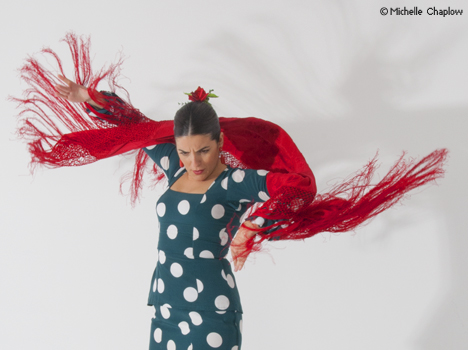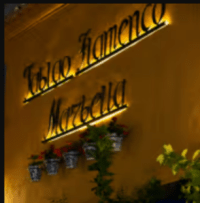
The origins | Spontanious or academic?
Most of today’s flamencologists will agree that the baile flamenco has descended from the ancient dances of the Indian Hindus.
Although the flamenco dance has shed many of the elements of the Indian religious dances that will unfold a story with set eye and facial movements, it does still have similarities with the Indian dance.
Without scripts or structured compositions, the Flamenco artists let themselves be carried away by improvisation and the passion of flamenco. Witness dancing and singing, where the a cappella voice, the guitar chords and the rhythm of the dancers will fill the stage. Dining optional. Tickets for Flamenco Show at Tablao Flamenco in Marbella.
The early flamenco dancers, especially the woman, concentrated more on the upper body and arm movements, similar to that of the Indian Bharata Natya, where the dance is focused on arm movements and facial expressions.
Also from India is the Kathuk, which is a dance performed by men and woman, where the very intricate footwork has similarities to the zapateado in flamenco.
These dances reached Spain as early as the Greek times, 500-250 BC, where Indian dancers where brought into Spain via the port of Gadir, today known as Cádiz, to entertain the royals of the time. The arrival of the Moors nearly one thousand years later, and also the gypsies, who brought with them, dance and music styles from Pakistan and Persia enriched the existing andalucian styles.
Many theorists lay the blame for the lack of footwork in the early female baile flamenco on the Muslim discouragement for women not to show their legs.
The zapateado or intricate footwork displayed by the dancer was not introduced into the female dance routine until the early twentieth century.
The decrees of the 16 th century, where Moors, Jews, and gypsies were persecuted, resulted in these outcasts going underground, and taking with them their music and dances, and this is where it stayed, and this is thought to be the very beginning of the formation of flamenco.
The style of dance we see performed today has changed considerably since these times, and now styles of flamenco song that were never danced are being taken up by modern dancers striving to find new directions for the flamenco dance.
There is a phrase, which says, “When you learn to dance, you must also learn how to forget it.”
All that he has been taught must at times be ignored, and the dancer will rely on the wisdom that flows in his blood, something that he inherited from an age-old tradition.
He must feel the rhythm of his own heart beat and let that guide him with his interpretation, and with his natural instinct, and the knowledge of how to use the rhythm of his heart, he will unleash a mysterious force, searching the most inner depths of his soul to attain a certain high, when the spirits appear to guide him and the duende fills the dance.
This type of dance will not normally be witnessed in a commercial setting, but it is possible in an intimate surrounding where the person dancing is transformed by the flamenco, unaware of anything around him other than the rhythm of the song, drawing his inspiration from the genetic sediment that lies in his soul.
This is the best possible way to witness flamenco dance, on the spur of the moment when someone feels entranced by the music, since the purest of dance exists in the body of those who know how to listen to its rhythmical call, and the more simple the dance, the better.
Outside of its natural surroundings, flamenco can appear dull and weak, rather like an uprooted plant, but in an old taverna or the small backroom of a bodega, where the smokey atmosphere and the scorched, cracked voice of the singer combined with the passionate tones of the flamenco guitar accompanying the solo dancer can sometimes leave you mesmerized.
It is the belief of many, that you cannot be taught flamenco; it is something that you are born into, an age-old secret that the only gypsies hold in their hearts.
Dance is one of the most beautiful ways for a performer to express himself, letting his character shape the routine, if he is a good dancer he will not be interested in flashy techniques or showmanship, just intent in relaying what he feels for the dance at that particular moment.
In the commercial establishments it is most commonly the dancers that the audience is there to see, and anything the singer or guitarist is doing is considered unimportant, because they will most probably not understand what lies inside the music.
Even if they have no knowledge of flamenco they can appreciate the grace and passion of the dancer, and the sensual, rhythmical, and graceful movements will normally be enough to satisfy the uninitiated.
If it is pure jondo dance you are looking for, then you will not normally find it in the tablaos, but if it is an enjoyable nights entertainment, then the tablaos are good places to see flamenco dance.
 |
| Flamenco dancer, Sara Baras. |
There is a release in spontaneous dancing that does not exist in academic, choreographed dancing, and the two different styles are considered as separate arts, rather like the guitar soloists as opposed to the accompanists.
Flamenco dance was initially a solo act, but it was with the invention of the café cantantes that dance troupes were formed, and today many of the top dancers have their own companies.
These companies can have up to twenty dancers on stage at the same time, and it would be with disastrous effects if the routines were not choreographed.
Today these flamenco troupes take shows to the theaters and arenas not only in Andalucía, but to the rest of the world, and in London’s Sadlers Wells theatre, where they hold an annual festival of flamenco, you will have to book months in advance to obtain a ticket.
Today flamenco dance is becoming more popular world wide, but these styles are now mixed with classic Spanish dance as well as ballet.
To witness jondo style flamenco dance today you will have to seek out the peñas and flamenco recitals that are aimed at the purer side of this fantastic art.
The fiesteros, which are normally of the older generation of artistes who sing and dance, will show you that there is still room for both sides of this art, and whether it is the tablaos, the theaters, or the antiquated jondo style of dance you prefer, flamenco is one of the most visual and emotive forms of expression, and to witness a passionate display of flamenco dance will leave most people impassioned.
Book your stay in Andalucia Now!
